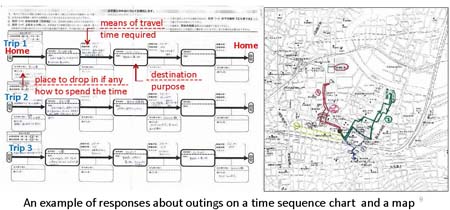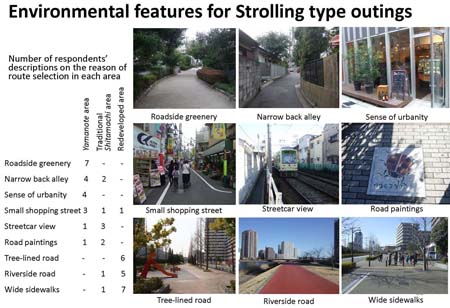 The effect of the outdoor environment on outings by mothers with small children The effect of the outdoor environment on outings by mothers with small children
<Proceedings 22nd International Conference of the IAPS, p. 232, June
2012.>
Ohno, R., Oshiumi, Y., Yin, Q.
|
The increasing nuclearization of Japanese urban families has left young
homemaking mothers often feeling isolated and vulnerable to the stresses
of childrearing. Many of these parents welcome venturing from the house
for some diversion and social interaction, making it doubly important for
society to create outdoor environments that support going out with small
children.
The present study discusses a questionnaire survey comparing young mothers’
habitual outings in four Tokyo neighborhoods?one long-established and one
newly developed residential area each from the largely white-collar yamanote
district to the west and the traditionally more commercial shitamachi district
to the east. Respondents set down destinations, purposes, time required,
and means of travel on a time sequence chart and recorded routes on a map.
In all areas, the most popular destinations were the supermarket and city
park. Residents of the new neighborhoods, however, headed to larger parks
and shopping complexes, while in the older shitamachi neighborhood, respondents
frequently patronized small shopping streets where they could enjoy talking
with shopkeepers. Routes were typically selected according to functional
considerations such as traffic safety and smoothness of the paving, a concern
particularly for stroller users. Wide sidewalks were preferred because
the mothers could walk side by side with friends while chatting. At the
same time, recreational criteria were also cited, including the presence
of roadside greenery, running water, or objects and people stimulating
to the children. The older neighborhoods had more routes satisfying recreational
needs than the newly developed ones, which in turn were better at answering
functional needs.
The results highlight that attempts to design outdoor environments for
parents with small children need to address not only safety and accessibility,
but also the demand for stimulation and company. |

 |
|
|
 The
Psychological Pressure of Houses over Adjacent of Exterior Space The
Psychological Pressure of Houses over Adjacent of Exterior Space
|
|
<Journal of Architecture, Planning and Environmental Engineering, No.461, Pp.
133-139, Mar. 2000>
|
| Shigeo Kobayaashi, Ryoichi Yanai, Ryuzo Ohno |
 |
This research examines what physical features of a detected
house are relevant to the intensity of psychological pressure on the
passers-by. Four houses in a exhibition place were selected as
experimental targets and sixteen subjects were asked to rate how much pressure
they felt at given points on the street at daytime and nighttime. The result
suggested that the intensity of psychological pressure generally depended on the size
of apparent house profile seen from the street. Therefore, an explanatory model was formulated using the solid
angle of the house facade and the sliding glass doors and main entrance. The
weights for these elements varied with each subject. In the nighttime
situation, the fitness of the model was improved when two more variables were
added, namely the amount of the illumination received as the viewpoint and the
amount of the illumination emitted by the house windows.
|
TOPへ
|
|
|
|